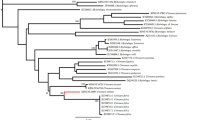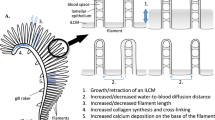Abstract
We have examined metabolic depression in the land snail (Helix aspersa) during estivation, and have developed a tissue model of metabolic depression using an in vitro mantle preparation. The metabolic rate ofH. aspersa is depressed by 84% in vivo within 4 weeks of onset of estivation, and this metabolic depression is accompanied by a decrease in haemolymphPO2 and pH, and an increase in haemolymphPCO2. The in vitro mantle preparation has a stable O2 consumption and energy charge, and an energy charge similar to that of mantle in vivo. The in vitro mantle is an O2-conforming tissue, withVO2 varying curvilinearly withPO2. Consequently, we have developed a mathematical method of calculating tissueVO2 at anyPO2. These calculations show that under appropriate incubation conditions of pH andPO2, the mantle from estivating animals shows a stable in vitro metabolic depression of 48% compared to mantle from control snails. The extrinsic effects ofPO2 and pH account for 70% of the total in vitro metabolic depression of mantle tissue; intrinsic effectors contribute a further 30%.
Similar content being viewed by others
Abbreviations
- BMS :
-
blood micro system
- MD :
-
inetabolic depression
- MR :
-
metabolic rate
- [O 2]:
-
concentration of oxygen
- PCO 2 :
-
partial pressure of carbon dioxide
- PO 2 :
-
partial pressure of oxygen
- SE :
-
standard error
- STP :
-
standard temperature and pressure
- VO 2 :
-
rate of oxygen consumption
References
Barnhart MC (1986) Control of acid-base status in active and dormant land snails,Otala lactea (Pulmonata, Helicidae). J Comp Physiol B 156:347–354
Barnhart MC (1989) Respiratory acidosis and metabolic depression in dormant invertebrates. In: Malan A, Canguilhem B (eds) Living in the cold. John Libbey, pp 321–331
Barnhart MC, McMahon BR (1988) Depression of aerobic metabolism and intracellular pH by hypercapnia in land snails,Otalalactea. J Exp Biol 138:289–299
Barnhart MC (1992) Acid-base regulation in pulmonate molluscs. J Exp Zool 263:120–126
Bergmeyer H (1985) Methods of enzymatic analysis, Vol VII. VCH Weinheim
Brooks SPJ, Storey KB (1994) Metabolic depression in land snails: In vitro analysis of protein kinase involvement in pyruvate kinase control in isolatedOtala lactea tissues. J Exp Zool 269: 507–514
Carpenter JF, Hand SC (1986) Arrestment of carbohydrate metabolism during anaerobic dormancy and aerobic acidosis inArtemia embryos: determination of pH-sensitive control points. J Comp Physiol B 156:451–459
Coulon-Bublex M, Dorel C (1991) The arrest of embryogenesis at gastrula state in the diapausing silkwormBombyx mori is related to the synthesis of protein P61. Roux's Arch Dev Biol 199: 469–475
Depocas F, Hart JS (1957) Use of the Pauling oxygen analyser for measurement of oxygen consumption of animals in open-circuit systems and in short-lag, closed circuit apparatus. J Appl Physiol 10:388–392
Doll CJ, Hochachka PW, Reiner PB (1991) Channel arrest: implications from membrane resistance in turtle neurones. Am J Physiol 261:R1321-R1324
Flanigan JE, Withers PC, Fuery CJ, Guppy M (1993) Metabolic depression and Na+/K+ gradients in the aestivating Australian goldfields frog,Neobatrachus wilsmorei. J Comp Physiol B 163: 587–593
Flanigan JE, Withers PC, Guppy M (1991) In vitro metabolic depression of tissues from the aestivating frogNeobatrachus pelobatoides. J Exp Biol 161:273–283
Fuery CJ, Withers PC, Hobbs A (1992) The role of protein synthesis in metabolic depression. Abstract Proc Aust Soc Biochem Mol Biol POS-2-6
Glasheen JS, Hand SC (1988) Anhydrobiosis in embryos of the brine shrimpArtemia: characterization of metabolic arrest during reductions in cell-associated water. J Exp Biol 135:363–380
Goldbeter A, Koshland DE Jr (1987) Energy expenditure in the control of biochemical systems by covalent modification. J Biol Chem 262:4460–4471
Guppy M, Fuery CJ, Flanigan JE (1994) Biochemical principles of metabolic depression. Comp Biochem Physiol 109B:175–189
Hand SC, Gnaiger E (1988) Anaerobic dormancy quantified inArtemia embryos: a calorimetric test of the control mechanism. Science 239:1425–1427
Herreid CF (1977) Metabolism of land snails (Otala lactea) during dormancy, arousal and activity. Comp Biochem Physiol 56A: 211–215
Hershey JWB (1989) Protein phosphorylation controls translation rates. J Biol Chem 264:20823–20826
Hofmann GE, Hand SC (1994) Global arrest of translation during invertebrate quiescence. Proc Natl Acad Sci USA 91: 8492–8496
Horne FR (1973) The utilization of food stuffs and urea production by a land snail during estivation. Biol Bull 144:321–330
Isfort RJ, Cody DB, Asquith TN, Ridder GM, Stuard GM, Leboeuf RA (1993) Induction of protein phosphorylation, protein synthesis, immediate-early-gene expression and cellular proliferation by intracellular pH modulation. Eur J Biochem 213:349–357
Jackson DC et al. (1991)31P-NMR study of normoxic and anoxic perfused turtle heart during graded CO2 and lactic acidosis. Am J Physiol 260:R1130-R1136
Joplin KH, Denlinger DL (1989) Cycles of protein synthesis during pupal diapause in the flesh flySarcophaga crassipalpis. Arch Insect Biochem Physiol 12:111–122
Kondo N, Kondo J (1992) Identification of novel blood proteins specific for mammalian hibernation. J Biol Chem 267:473–478
Machin J (1975) Water relationships. In: Fretter V, Peake J (eds) The pulmonates. Academic Press, New York, pp 105–163
Malan A, Rodeau JL, Daull F (1985) Intracellular pH in hibernation and respiratory acidosis in the European hamster. J Comp Physiol B 156:251–258
Midsukami M (1979) Physiological salines. The formulae for animals from protozoa to vertebrata. Keigaku, Tokyo
Nestler JR (1990) Intracellular pH during daily torpor inPeromyscus maniculatus. J Comp Physiol 159:661–666
Rees BB, Hand SC (1990) Heat dissipation, gas exchange and acidbase status in the land snailOreohelix during short-term estivation. J Exp Biol 152:77–92
Rees BB, Hand SC (1991) Regulation of glycolysis in the land snailOreohelix during estivation and artificial hypercapnia. J Comp Physiol B 161:237–246
Rees BB, Malhotra D, Shapiro JI, Hand SC (1991) Intracellular pH decreases during entry into estivation in the land snailOreohelix strigosa. J Exp Biol 159:525–530
Riddle WA (1977) Comparative respiratory physiology of a desert snail,Rabdotus schiedeanus, and a garden snail,Helix aspersa. Comp Biochem Physiol 56A:369–373
Schmidt-Nielson K, Taylor CR, Sholnik A (1971) Desert snails: problems of heat, water and food. J Exp Biol 55:385–398
Scholnick DA, Snyder GK, Spell AR (1994) Acid-Base status of a pulmonate land snail (Helix aspersa) and a prosobranch amphibious snail (Pomacea bridgesi) during dormancy. J Exp Zool 268:293–298
Schulz JT, Cantley LC (1985) Characterization of an endogenous, membrane-bound kinase that phosphorylates the Na,K-ATPase in friend erythroleukemia cells. In: Glynn I, Ellory C (eds) The sodium pump. Charlesworth, Huddersfield, pp 689–694
Storey KB (1993) Molecular mechanisms of metabolic arrest in molluscs. In: Hochachka PW, Lutz PL, Sick TJ, Rosenthal M, Thillart B v d. (eds) Surviving hypoxia: mechanism of control and adaptation. CRC Press, Boca Raton, pp 253–269
Thomas MA, Agard JBR (1992) Metabolic rate depression in the ampullariid snailPomacea urceus (Müller) during aestivation and anaerobiosis. Comp Biochem Physiol 102A:675–678
Vorhaben JE, Klotz AV, Campbell JW (1984) Activity and oxidative metabolism of the land snailHelix aspersal. Physiol Zool 57: 357–365
Withers PC (1992) Comparative animal physiology. Saunders College Publishing, Fort Worth
Author information
Authors and Affiliations
Additional information
Communicated by H. Huddart
Rights and permissions
About this article
Cite this article
Pedler, S., Fuery, C.J., Withers, P.C. et al. Effectors of metabolic depression in an estivating pulmonate snail (Helix aspersa): whole animal and in vitro tissue studies. J Comp Physiol B 166, 375–381 (1996). https://doi.org/10.1007/BF02336920
Accepted:
Issue Date:
DOI: https://doi.org/10.1007/BF02336920




